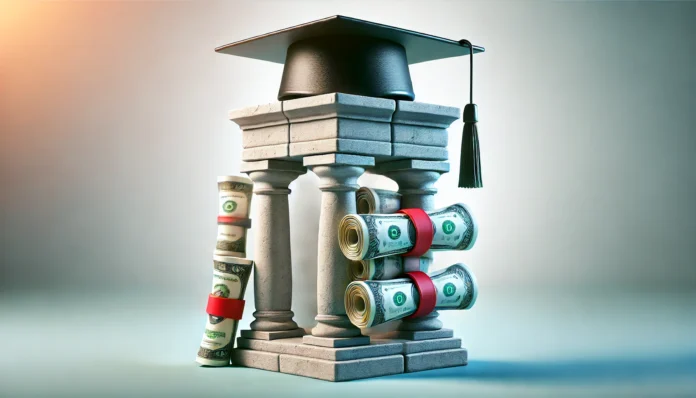Understanding Cornerstone Student Loans and Their Role in Education Financing
For many students, financing higher education requires taking out loans to cover tuition, books, and living expenses. Cornerstone Student Loans play a critical role in providing financial aid to students who may not have the means to pay upfront for their education. As a student loan servicer, Cornerstone assists borrowers in managing their federal student loans by providing repayment options, customer support, and guidance on financial responsibilities.
You may also like: Federal Direct Consolidation Loan: A Smart Strategy to Simplify Student Debt
Navigating student loan repayment can be overwhelming, particularly for recent graduates facing the realities of large debt obligations. Understanding the terms and conditions associated with a Cornerstone Education Loan is essential for borrowers looking to develop a financial strategy that aligns with their career trajectory and income level. Whether dealing with standard repayment plans or income-driven options, knowing the full scope of available choices ensures responsible borrowing and financial sustainability.
Given the significant financial burden that student loans can impose, borrowers must take proactive steps to manage their debt effectively. Cornerstone Student Loans offers various repayment options, deferment opportunities, and financial counseling to assist borrowers in making informed decisions. By leveraging these services, students and graduates can avoid default, minimize interest accrual, and work toward financial freedom in a structured manner.

Managing Your Cornerstone Education Loan: Essential Strategies for Borrowers
Effective loan management requires a combination of financial literacy, strategic planning, and proactive decision-making. Borrowers should begin by reviewing the specifics of their Cornerstone Education Loan, including interest rates, loan terms, and monthly payment requirements. Understanding the financial obligations associated with these loans is the first step toward developing a repayment strategy that minimizes long-term costs.
One key strategy for managing student loan debt is to make payments beyond the minimum amount whenever possible. By allocating additional funds toward principal repayment, borrowers can reduce the overall interest accrued over the life of the loan. Additionally, setting up automatic payments can prevent missed due dates and, in some cases, qualify borrowers for interest rate reductions.
Borrowers facing financial difficulties may explore deferment and forbearance options available through Cornerstone Student Loans. While these programs provide temporary relief, they should be used strategically, as interest may continue to accrue depending on the loan type. Exploring alternative repayment plans, such as income-driven repayment, can also provide long-term solutions for those with variable or lower incomes.

Repayment Options Available for Cornerstone Student Loans
Cornerstone Student Loans offers multiple repayment options tailored to different financial circumstances. Borrowers may choose from standard, graduated, extended, or income-driven repayment plans, each with unique benefits and drawbacks. Selecting the most appropriate plan requires careful consideration of one’s financial situation, career prospects, and overall debt burden.
The standard repayment plan involves fixed monthly payments over a 10-year period. While this option allows borrowers to pay off their loans faster and with less interest, it may not be feasible for those with high debt balances or limited income. A graduated repayment plan, on the other hand, starts with lower payments that gradually increase over time, making it a suitable choice for individuals expecting salary growth in their careers.
Income-driven repayment plans, such as Income-Based Repayment (IBR) and Pay As You Earn (PAYE), adjust monthly payments based on income and family size. These plans provide financial relief for borrowers with lower earnings, though they may extend the repayment term and increase the total interest paid over time. Understanding the nuances of each repayment option enables borrowers to make informed decisions that align with their financial goals.

The Impact of Interest Rates on Cornerstone Education Loan Repayment
Interest rates significantly affect the overall cost of student loans and the total amount repaid over time. Federal student loans serviced by Cornerstone typically have fixed interest rates, meaning they remain constant throughout the loan’s duration. While this provides stability, borrowers should still be mindful of how interest accrues and impacts their financial planning.
For borrowers with unsubsidized federal loans, interest begins accruing as soon as the loan is disbursed. Making interest payments during school or deferment periods can prevent capitalization, where unpaid interest is added to the principal balance. This proactive approach helps reduce the overall financial burden and shortens the repayment timeline.
Refinancing student loans may be an option for borrowers looking to secure lower interest rates. While Cornerstone Student Loans does not offer refinancing services, borrowers may explore private lenders that provide competitive rates based on creditworthiness. However, refinancing federal loans into private loans eliminates federal protections, including income-driven repayment and loan forgiveness options, making it essential to weigh the pros and cons carefully.
How to Avoid Default on Your Cornerstone Student Loans
Defaulting on student loans can have severe financial consequences, including damage to credit scores, wage garnishment, and loss of eligibility for federal loan benefits. Borrowers struggling to make payments should explore alternatives before reaching default status. Communication with Cornerstone Student Loans is key to finding viable solutions.
Setting up an income-driven repayment plan can provide immediate relief by reducing monthly payments based on income. Additionally, requesting deferment or forbearance may be necessary for those experiencing temporary financial hardship. While these options provide short-term relief, they should not be relied upon indefinitely, as they can lead to increased loan balances due to accumulating interest.
For borrowers already in default, loan rehabilitation or consolidation may be possible solutions. Rehabilitation involves making a series of on-time payments to restore the loan to good standing, while consolidation combines multiple loans into a single new loan with updated repayment terms. Understanding these options helps borrowers navigate financial difficulties while preserving their credit and financial future.
The Role of Loan Forgiveness Programs in Managing Cornerstone Student Loans
Loan forgiveness programs can provide relief for borrowers who meet specific criteria, such as working in public service or education. The Public Service Loan Forgiveness (PSLF) program is one of the most well-known options, allowing borrowers to have their remaining loan balance forgiven after making 120 qualifying payments while working for a qualifying employer.
Teacher Loan Forgiveness is another option for educators who work in low-income schools for a designated period. This program provides partial loan forgiveness, reducing the overall financial burden for teachers committed to serving underprivileged communities. Other federal forgiveness programs cater to specific professions, such as healthcare workers and nonprofit employees.
Understanding eligibility requirements and staying up to date with program changes are crucial for borrowers pursuing loan forgiveness. Consulting with Cornerstone Student Loans or a financial advisor can provide clarity on available options and ensure that borrowers take the necessary steps to qualify for forgiveness benefits.
Frequently Asked Questions (FAQ)
What are Cornerstone student loans and how do they differ from other federal student loans?
Cornerstone student loans are federal student loans managed by Cornerstone, a loan servicer contracted by the U.S. Department of Education. Unlike private student loans, these loans come with federal protections such as income-driven repayment plans, deferment, and forbearance options. Borrowers of Cornerstone education loans may have access to loan forgiveness programs like Public Service Loan Forgiveness (PSLF) if they meet eligibility criteria. Additionally, Cornerstone provides customer support for repayment assistance and ensures compliance with federal student loan guidelines. Understanding the features of Cornerstone student loans helps borrowers take full advantage of their repayment options.
How can borrowers manage repayment of their Cornerstone education loan effectively?
Managing repayment of a Cornerstone education loan requires careful planning and an understanding of available options. Borrowers should review their loan terms and consider enrolling in an income-driven repayment plan if monthly payments become unmanageable. Cornerstone student loans offer deferment and forbearance options in cases of financial hardship, allowing temporary relief from payments. Making extra payments toward the principal can reduce interest accrual and shorten the loan term, saving money over time. Staying informed about potential loan forgiveness programs can also provide long-term financial benefits.
What are the eligibility requirements for loan forgiveness under Cornerstone student loans?
Borrowers with Cornerstone student loans may be eligible for loan forgiveness through federal programs such as Public Service Loan Forgiveness (PSLF) and Teacher Loan Forgiveness. To qualify for PSLF, borrowers must work for a qualifying employer, such as a government agency or nonprofit organization, and make 120 qualifying monthly payments. Teacher Loan Forgiveness applies to educators who have worked in low-income schools for at least five years. Other loan forgiveness options may be available for borrowers with disabilities or those participating in certain income-driven repayment plans. Checking eligibility criteria regularly can help borrowers maximize the benefits of their Cornerstone education loan.
How do borrowers switch repayment plans for their Cornerstone education loan?
Borrowers can switch repayment plans for their Cornerstone education loan by submitting a request through Cornerstone’s online portal or by contacting customer service. The most common switch occurs when borrowers move from a standard repayment plan to an income-driven repayment (IDR) plan to lower monthly payments. Borrowers can also opt for an extended or graduated repayment plan, depending on their financial goals. Cornerstone student loans allow for flexible adjustments to repayment terms, but it’s essential to understand the long-term interest implications before making a switch. Reviewing repayment plan options annually ensures that borrowers are on the best path toward debt reduction.
What should borrowers do if they are struggling to make payments on Cornerstone student loans?
Borrowers struggling with payments on Cornerstone student loans should explore options such as deferment, forbearance, or income-driven repayment plans. Deferment may be available for those returning to school, serving in the military, or experiencing financial hardship. Forbearance provides temporary relief by pausing payments, though interest continues to accrue. Income-driven repayment plans adjust monthly payments based on earnings, making them more affordable for those with limited income. Seeking assistance early from Cornerstone’s customer support can prevent missed payments and potential loan default.
Are Cornerstone education loan borrowers affected by federal student loan policy changes?
Yes, Cornerstone education loan borrowers are subject to changes in federal student loan policies, including updates to repayment plans, forgiveness programs, and temporary relief measures. For instance, policy changes related to student loan forbearance during national emergencies may impact repayment schedules. Borrowers should stay informed by monitoring updates from the U.S. Department of Education and Cornerstone student loans’ official website. Understanding policy changes ensures that borrowers take advantage of new benefits or protections. Proactively adjusting repayment strategies in response to policy shifts can provide financial relief.
What happens if a borrower’s Cornerstone student loans are transferred to another servicer?
Occasionally, Cornerstone student loans may be transferred to another loan servicer as part of federal contract changes. If this happens, borrowers will receive notifications with details about their new servicer and instructions on how to access their account. It’s crucial for borrowers to verify that their loan balance, repayment plan, and payment history transfer correctly to avoid any discrepancies. Borrowers should continue making payments as scheduled and update autopay settings if necessary. Being proactive during a loan servicer transfer ensures a smooth transition with minimal disruption to repayment.
Can Cornerstone student loans be refinanced through a private lender?
Yes, borrowers can refinance Cornerstone student loans through private lenders if they qualify for better interest rates and repayment terms. However, refinancing a federal student loan with a private lender results in the loss of federal protections, such as income-driven repayment plans, deferment, and forgiveness options. It’s essential for borrowers to weigh the benefits of lower interest rates against the potential risks of losing federal benefits. Those with strong credit and stable income may find refinancing beneficial, while others may prefer to keep their Cornerstone education loan within the federal system. Careful consideration of long-term financial goals is crucial before refinancing.
What are the best strategies for paying off Cornerstone student loans faster?
To pay off Cornerstone student loans faster, borrowers can make extra payments toward the principal balance to reduce interest accrual. Enrolling in autopay may qualify borrowers for interest rate discounts, helping to lower the total cost of the loan. Refinancing to a lower interest rate may also speed up repayment for those who no longer need federal benefits. Additionally, using financial windfalls such as tax refunds or work bonuses to make lump-sum payments can accelerate loan payoff. Developing a structured repayment plan and avoiding unnecessary expenses can lead to significant savings over time.
How can borrowers contact Cornerstone for assistance with their student loans?
Borrowers can contact Cornerstone for assistance with their student loans through their official website, phone support, or email services. Customer service representatives can provide information about repayment options, loan forgiveness programs, and deferment or forbearance applications. Cornerstone student loans also offer online account management, allowing borrowers to track balances, make payments, and request repayment changes. It’s advisable to reach out to Cornerstone as soon as repayment concerns arise to explore available solutions. Proactively managing communication with Cornerstone ensures that borrowers remain in good standing with their loans.
Conclusion: Taking Control of Your Student Loan Repayment Journey
Managing and repaying Cornerstone Student Loans requires a proactive approach and informed decision-making. By understanding repayment options, interest rates, and available relief programs, borrowers can develop effective strategies to minimize debt burden and achieve financial stability. Whether choosing a repayment plan, seeking forgiveness opportunities, or exploring refinancing options, each step plays a role in shaping long-term financial success.
Student loan debt can be challenging, but with careful planning and utilization of available resources, borrowers can navigate repayment with confidence. Staying informed, making timely payments, and taking advantage of federal protections ensure that education debt remains manageable. Cornerstone Student Loans provides the necessary tools and support to help borrowers succeed, making it essential to engage with their services and explore all available options for a financially secure future.
student loan repayment, financial literacy, managing education debt, loan forgiveness programs, student loan servicers, federal loan repayment, financial planning, loan interest rates, student debt relief, debt management strategies, income-driven repayment, budgeting for student loans, refinancing student loans, preventing loan default, higher education financing, personal finance strategies, navigating student loan options, loan servicer comparison, financial wellness, debt reduction techniques
Further Reading:
CornerStone Education Loan Services Review 2025
CornerStone No Longer Servicing Federal Student Loans
CornerStone Education Loan Services Review 2024
The information provided in this article is for general informational purposes only and is not intended to constitute financial, investment, legal, tax, or other professional advice. The content should not be relied upon for making any financial or investment decisions. Readers are encouraged to consult with licensed professionals, such as financial advisors, attorneys, or tax experts, to obtain personalized advice tailored to their individual circumstances. The author and publisher disclaim any liability for any actions taken or not taken based on the information provided in this article.





